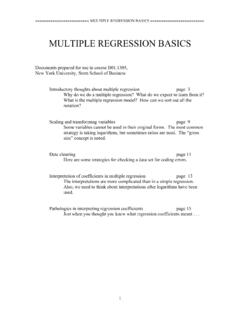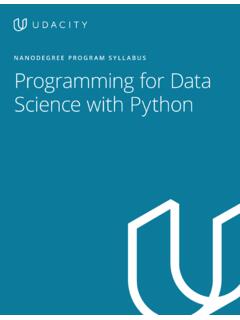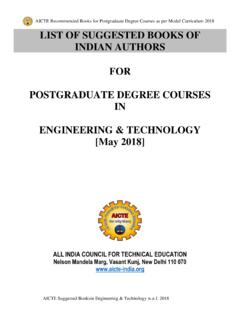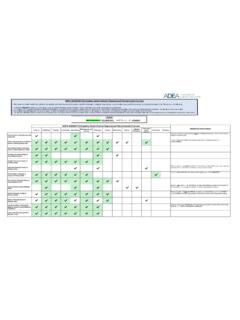Transcription of A Modern Introduction to Probability and Statistics
1 Dekking C. Lopuhaa MeesterA Modern Introduction toProbability and StatisticsUnderstanding Why and HowWith 120 FiguresFrederik Michel DekkingCornelis KraaikampHendrik Paul Lopuhaa Ludolf Erwin MeesterDelft Institute of Applied MathematicsDelft University of TechnologyMekelweg 42628 CD DelftThe NetherlandsWhilst we have made considerable efforts to contact all holders of copyright material contained in thisbook, we may have failed to locate some of them. Should holders wish to contact the Publisher, wewill be happy to come to some arrangement with Library Cataloguing in Publication DataA Modern Introduction to Probability and Statistics . (Springer texts in Statistics )1. Probabilities 2. Mathematical statisticsI. Dekking, F. 1852338962 Library of Congress Cataloging-in-Publication DataA Modern Introduction to Probability and Statistics : understanding why and how / Dekking.
2 [etal.].p. cm. (Springer texts in Statistics )Includes bibliographical references and 1-85233-896-21. Probabilities Textbooks. 2. Mathematical Statistics Textbooks. I. Dekking, dc222004057700 Apart from any fair dealing for the purposes of research or private study, or criticism or review, aspermitted under the Copyright, Designs and Patents Act 1988, this publication may only be reproduced,stored or transmitted, in any form or by any means, with the prior permission in writing of the publish-ers, or in the case of reprographic reproduction in accordance with the terms of licences issued by theCopyright Licensing Agency. Enquiries concerning reproduction outside those terms should be sent tothe : 1-85233-896-2 ISBN-13: 978-1-85233-896-1 Springer Science+Business Springer-Verlag London Limited 2005 The use of registered names, trademarks, etc. in this publication does not imply, even in the absenceof a specific statement, that such names are exempt from the relevant laws and regulations and thereforefree for general publisher makes no representation, express or implied, with regard to the accuracy of the informa-tion contained in this book and cannot accept any legal responsibility or liability for any errors oromissions that may be in the United States of America12/3830/543210 Printed on acid-free paper SPIN 10943403 PrefaceProbability and Statistics are fascinating subjects on the interface betweenmathematics and applied sciences that help us understand and solve practicalproblems.
3 We believe that you, by learning how stochastic methods comeabout and why they work, will be able to understand the meaning of statisticalstatements as well as judge the quality of their content, when facing suchproblems on your own. Our philosophy is one ofhowandwhy: instead of justpresenting stochastic methods as cookbook recipes, we prefer to explain theprinciples behind this book you will find the basics of Probability theory and Statistics . Inaddition, there are several topics that go somewhat beyond the basics butthat ought to be present in an introductory course: simulation, the Poissonprocess, the law of large numbers, and the central limit theorem. Computershave brought many changes in Statistics . In particular, the bootstrap hasearned its place. It provides the possibility to derive confidence intervals andperform tests of hypotheses where traditional (normal approximation or largesample) methods are inappropriate.
4 It is a Modern useful tool one should learnabout, we and datasets in this book are mostly from real-life situations, atleast that is what we looked for in illustrations of the material. Anybody whohas inspected datasets with the purpose of using them as elementary examplesknows that this is hard: on the one hand, you do not want to boldly stateassumptions that are clearly not satisfied; on the other hand, long explanationsconcerning side issues distract from the main points. We hope that we founda good middle first course in calculus is needed as a prerequisite for this book. In additionto high-school algebra, some infinite series are used (exponential, geometric).Integration and differentiation are the most important skills, mainly concern-ing one variable (the exceptions, two dimensional integrals, are encountered inChapters 9 11). Although the mathematics is kept to a minimum, we strivedVIPrefaceto be mathematically correct throughout the book.
5 With respect to probabil-ity and Statistics the book is book is aimed at undergraduate engineering students, and students frommore business-oriented studies (who may gloss over some of the more mathe-matically oriented parts). At our own university we also use it for students inapplied mathematics (where we put a little more emphasis on the math andadd topics like combinatorics, conditional expectations, and generating func-tions). It is designed for a one-semestercourse: on average two hours in classper chapter, the first for a lecture, the second doing exercises. The materialis also well-suited for self-study, as we know from have divided attention about evenly between Probability and very first chapter is a sampler with differently flavored introductory ex-amples, ranging from scientific success stories to a controversial puzzle. Topicsthat follow are elementary Probability theory, simulation, joint distributions,the law of large numbers, the central limit theorem, statistical modeling (in-formal: why and how we can draw inference from data), data analysis, thebootstrap, estimation, simple linear regression, confidence intervals, and hy-pothesis testing.
6 Instead of a few chapters with a long list of discrete andcontinuous distributions, with an enumeration of the important attributes ofeach, we introduce a few distributions when presenting the concepts and theothers where they arise (more) naturally. A list of distributions and theircharacteristics is found in Appendix the exception of the first one, chapters in this book consist of three mainparts. First, about four sections discussing new material, interspersed with ahandful of so-called Quick exercises. Working these two-or-three-minute exercises should help to master the material and provide a break from readingto do something more active. On about two dozen occasions you will findindented paragraphs labeledRemark, where we felt the need to discuss moremathematical details or background material. These remarks can be skippedwithout loss of continuity; in most cases they require a bit more mathematicalmaturity.
7 Whenever persons are introduced in examples we have determinedtheir sex by looking at the chapter number and applying the rule He is odd,she is even. Solutions to the quick exercises are found in the second to lastsection of each last section of each chapter is devoted to exercises, on average thirteenper chapter. For about half of the exercises, answers are given in Appendix C,and for half of these, full solutions in Appendix D. Exercises with both ashort answer and a full solution are marked with and those with only ashort answer are marked with (when more appropriate, for example, in Show that .. exercises, the short answer provides a hint to the key step).Typically, the section starts with some easy exercises and the order of thematerial in the chapter is more or less respected. More challenging exercisesare found at the of the material in this book would benefit from illustration with acomputer using statistical software.
8 A complete course should also involvecomputer exercises. Topics like simulation, the law of large numbers, thecentral limit theorem, and the bootstrap loudly call for this kind of experi-ence. For this purpose, all the datasets discussed in the book are available The same Web site also pro-vides access, for instructors, to a complete set of solutions to the exercises;go to the Springer online catalog or contact toapply for your , The NetherlandsF. M. DekkingJanuary 2005C. KraaikampH. P. Lopuha aL. E. MeesterContents1 Why Probability and Statistics ?.. Biometry:iris Killer football .. Cars and goats: the Monty Hall dilemma .. The space Statistics versus intelligence agencies .. The speedof light .. 92 Outcomes, events, and Sample Events .. Probability .. Products ofsamplespaces .. An infinite sample space.
9 Solutions to the Exercises .. 213 Conditional Probability and Conditional Probability .. The The law of total Probability and Bayes rule .. Independence .. Solutions to the Exercises .. 37 XContents4 Discrete random Randomvariables .. The Probability distribution of a discrete random variable .. The Bernoulliand binomialdistributions .. The Solutions to the Exercises .. 515 Continuous random Probability density functions .. The uniformdistribution .. The The Paretodistribution .. The Solutions to the Exercises .. 686 What is simulation? .. Generating Comparingtwo The single-serverqueue .. Solutions to the Exercises .. 857 Expectation and Threeexamples .. The Variance .. Solutions to the Exercises .. 998 Computations with random Transforming discrete random variables.
10 Transforming continuousrandom Jensen s Solutions to the Exercises ..1119 Joint distributions and Joint distributions of discrete random variables .. Joint distributions of continuous random variables .. Morethantwo randomvariables .. Independent Propagation of independence .. Solutions to the Exercises ..12710 Covariance and Expectationandjoint distributions .. Covariance .. The correlationcoefficient .. Solutions to the Exercises ..14411 More computations with more random Sums ofdiscreterandomvariables .. Sums ofcontinuous randomvariables .. Product and quotient of two random variables .. Solutions to the Exercises ..16312 The Poisson Random Taking a The Higher-dimensionalPoissonprocesses .. Solutions to the Exercises ..17613 The law of large Averagesvaryless .. Chebyshev s inequality .. The lawof Consequencesof the law of largenumbers.






